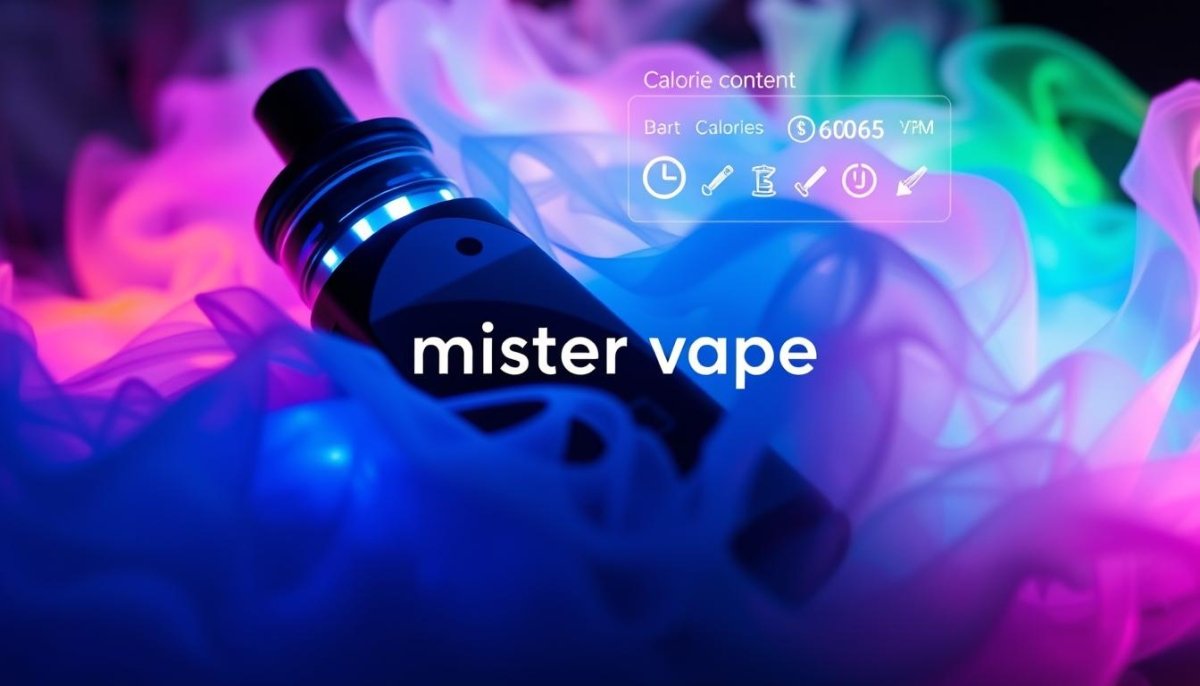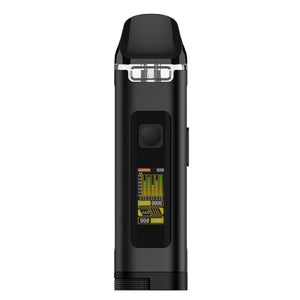How Many Calories Are in a Vape: Vaping Facts Guide

How Many Calories Are in a Vape: Vaping Facts Guide
Curious about calories in your vape? It's a common question among e-cigarette users. This guide explores the often-overlooked topic of vape calorie content.

E-liquids contain small amounts of calories. These come from ingredients like propylene glycol and vegetable glycerin. For frequent vapers, these calories aren't completely insignificant.
Knowing vape nutrition facts is crucial for calorie-conscious individuals. It helps you make informed decisions about your health and lifestyle choices.
Key Takeaways
- Vape juice contains a small number of calories
- The main caloric sources in e-liquids are propylene glycol and vegetable glycerin
- Flavourings can contribute additional calories to vape juice
- Frequent vaping may lead to a slight increase in daily calorie intake
- Understanding vape nutrition facts can help in making informed health choices
Understanding Vaping and Its Components
Vaping has gained popularity as an alternative to traditional smoking. This trend has raised questions about vape health effects and its connection to weight gain.
What is Vaping?
Vaping involves inhaling vapour from an electronic device. These gadgets heat liquid to create an aerosol for users to inhale. Unlike cigarettes, vaping doesn't burn tobacco, which affects its potential health impacts.
Common Ingredients in Vape Juice
Vape juice, or e-liquid, typically contains these ingredients:
- Propylene Glycol (PG)
- Vegetable Glycerin (VG)
- Flavourings
- Nicotine (optional)
These ingredients can influence vape health effects. They may also impact weight management for users.
How Vaping Differs from Smoking
Vaping and smoking have several key differences:
| Aspect | Vaping | Smoking |
|---|---|---|
| Combustion | No burning | Tobacco is burned |
| Chemicals produced | Fewer harmful chemicals | Thousands of chemicals |
| Odour | Less lingering smell | Strong, persistent odour |
| Nicotine delivery | Controllable | Fixed by cigarette type |
Vaping is often seen as less harmful than smoking. However, it's not risk-free. The long-term effects of vaping are still under study.
Researchers are exploring its impact on weight gain and overall health. More time is needed to fully understand vaping's consequences.
The Caloric Content of Vape Juice
Vaping has become a popular smoking alternative. Many people wonder about its impact on calorie intake. Let's explore the calories in vape juice and their effects.
What Makes Up the Calories in Vape?
Vape juice calories mainly come from its base ingredients. Propylene glycol and vegetable glycerin contain about 4 calories per gram. A typical 1 ml of e-liquid has roughly 1.2 calories.
The actual calorie intake from vaping is minimal. It's far less than what you'd get from food or drinks.
How Flavouring Concentrates Affect Calories
Flavouring concentrates add a small number of calories to vape juice. They typically contribute less than 1 calorie per ml. Sweet flavours often have more calories due to sweeteners.
However, the overall calorie impact from vaping remains very small.
| Vape Juice Component | Approximate Calories per ml |
|---|---|
| Base (PG/VG) | 1.2 |
| Flavouring | 0.1 - 0.5 |
| Nicotine | 0 |
Vaping has minimal calorie intake, but other health aspects need consideration. Always seek advice from healthcare professionals about vaping's effects on your health.
Comparing Vaping to Smoking Cigarettes
Vaping and traditional cigarette smoking have distinct features affecting calories and health. It's vital to understand these differences when considering vaping's impact on calorie intake and overall well-being.

Calories in a Cigarette vs. Vape
Cigarettes contain about 1-2 calories per stick. Vape juices may have slightly more due to flavourings and sweeteners.
However, the caloric difference is typically insignificant in terms of daily intake. Both options contribute minimally to overall calorie consumption.
| Consumption Method | Approximate Calories per Unit | Average Daily Intake (20 units) |
|---|---|---|
| Cigarette | 1-2 | 20-40 |
| Vape (per ml of e-liquid) | 4-5 | 80-100 |
Health Implications Beyond Calories
The health impacts of vaping and smoking differ greatly, despite similar calorie counts. Cigarettes contain thousands of harmful chemicals, many of which cause cancer.
Vaping typically involves fewer toxic substances. However, it's not risk-free and requires further study to fully understand its effects.
Early research suggests vaping may harm lung function less than smoking. Both habits can affect heart health, appetite, and metabolism.
These factors may indirectly influence calorie intake and weight management. More research is needed to fully grasp vaping's long-term effects.
"While vaping may have fewer immediate health risks than smoking, it's not a harmless activity. More research is needed to fully understand its long-term effects." - British Lung Foundation
Factors Influencing Calorie Count in Vaping
Knowing the calorie content in vaping is vital for those watching their diet. Several factors affect vaping calories. Let's explore these to understand their impact on your health.
Device Type and Technology
Your vaping device greatly influences calorie consumption. Advanced devices with adjustable settings can change the amount of e-liquid vaporised. This may affect your calorie intake.
Pod systems generally deliver fewer calories due to lower power output. Box mods, with higher wattage, can vaporise more e-liquid, potentially increasing calories. Disposable vapes typically have a fixed output, providing consistent calorie delivery.
- Pod systems: Generally deliver fewer calories due to lower power output
- Box mods: Higher wattage can vaporise more e-liquid, potentially increasing calorie intake
- Disposable vapes: Typically have a fixed output, providing consistent calorie delivery

Nicotine Levels and Their Impact
Nicotine concentration in e-liquids can indirectly affect vaping calorie intake. Higher nicotine levels may lead to less frequent vaping. This could potentially reduce overall calorie consumption.
| Nicotine Strength | Average Puffs per Day | Estimated Calories |
|---|---|---|
| 0 mg | 200 | 4-6 |
| 3 mg | 150 | 3-5 |
| 6 mg | 100 | 2-4 |
| 12 mg | 75 | 1-3 |
Vaping calories are minimal, but they're worth considering in your overall health plan. Remember, calories are just one aspect of vaping's effects on your wellbeing. Always consider the bigger picture when making health choices.
Estimating Calories Based on Usage
Knowing your vaping calorie intake is vital for diet-conscious vapers. Vaping isn't entirely calorie-free, despite common belief. Let's explore how to estimate vaping calories and their impact on daily intake.
How to Calculate Your Vaping Calories
Calculating vape nutrition facts is challenging but doable. Check your e-liquid's ingredients first. Most calories come from propylene glycol (PG) and vegetable glycerin (VG).
PG contains about 4 calories per gram. VG has around 4.32 calories per gram. These base liquids contribute the most to calorie content.
- Note the PG/VG ratio in your e-liquid
- Measure how much e-liquid you use daily (in ml)
- Multiply the volume by the calorie content of PG and VG
Average Daily Use and Calories
Typically, vapers use about 3-5ml of e-liquid daily. Let's look at potential calorie intake based on this average use:
| E-liquid Used (ml) | Approximate Calories (50/50 PG/VG) |
|---|---|
| 3 ml | 12-15 calories |
| 5 ml | 20-25 calories |
| 10 ml | 40-50 calories |
These figures are estimates. Your actual vaping calorie intake may vary. It depends on your specific e-liquid and vaping habits.
The calorie count seems low. However, it's worth considering if you're closely tracking your overall caloric intake.
Calories in Different Vape Flavours
Vape flavours play a crucial role in e-liquid calorie content. Understanding these differences helps vapers choose low-calorie options wisely. This knowledge empowers users to make informed decisions about their vaping habits.
Popular Flavours and Their Caloric Content
E-liquid flavours have varying calorie counts. Fruit and menthol options tend to be lower in calories. Dessert and cream-based flavours often contain more calories.
Here's a comparison of some popular flavours:
| Flavour | Calories per 10ml |
|---|---|
| Menthol | 2-5 |
| Strawberry | 5-10 |
| Tobacco | 10-15 |
| Vanilla Custard | 20-25 |
The Role of Sweeteners in Caloric Value
Sweeteners greatly affect vape juice calorie counts. Natural sweeteners like sucralose add calories to e-liquids. Artificial sweeteners can keep the calorie count low.
For low-calorie vaping, choose e-liquids with artificial sweeteners or none at all. This approach helps minimise calorie intake while enjoying your vaping experience.
Even high-calorie vape flavours contain fewer calories than traditional snacks or drinks. This makes vaping appealing for calorie-conscious individuals. However, it's vital to consider overall health impacts beyond just calories.
Myths and Facts About Vaping Calories
Vaping has sparked numerous debates about its caloric content and health effects. Let's explore the science behind vaping and separate fact from fiction.
Dispelling Common Misconceptions
Contrary to popular belief, vaping isn't entirely calorie-free. E-liquids often contain small amounts of calories from ingredients like propylene glycol and vegetable glycerin.
Vaping may indirectly affect weight through changes in appetite or metabolism. It's important to consider these potential effects when making lifestyle choices.
Understanding the Science Behind Vaping
When e-liquid is heated, it forms an aerosol that users inhale. This process doesn't add calories to your diet like eating or drinking does.
The body processes inhaled substances differently from ingested ones. E-liquids contain minimal calories, and individual responses to vaping can vary.
- E-liquids contain minimal calories
- Inhaled substances are processed differently than food
- Individual responses to vaping can vary
Vaping's caloric impact is generally negligible compared to dietary intake. However, it's crucial to consider all potential effects of vaping beyond just calorie count.
The Impact of Vaping on Diet and Lifestyle
Vaping's popularity has soared, yet its effects on diet and lifestyle remain unclear. This section examines how vaping might influence appetite and weight management. We'll explore vaping's potential impact on calorie intake.
How Vaping May Affect Appetite
Vaping can alter appetite in different ways. Some vapers report feeling less hungry, possibly due to nicotine's appetite-suppressing properties.
Certain e-liquid flavours may satisfy cravings for sweet or savoury foods. This could lead to reduced snacking and changes in eating patterns.
Vaping and Weight Management
The link between vaping and weight gain is not straightforward. Some use vaping to control weight, swapping high-calorie snacks for flavoured e-liquids.
Others may experience weight changes due to shifts in metabolism or eating habits. It's important to note that vaping isn't a proven weight loss method.
- Nicotine in e-liquids may boost metabolism slightly
- Flavoured vapes might reduce cravings for high-calorie foods
- Vaping could lead to mindless snacking for some users
Vaping's impact on calorie intake varies from person to person. It's crucial to maintain a balanced diet and healthy lifestyle, regardless of vaping habits.
For personalised advice on managing weight and well-being while vaping, consult healthcare professionals. They can provide tailored guidance for your specific needs.
Conclusion: Key Takeaways on Vaping Calories
Vaping calories are more complex than they seem. Vaping generally has fewer calories than traditional smoking. However, it's not entirely calorie-free.
Final Thoughts on Vaping and Health
Vape health effects go beyond calorie content. Low-calorie vaping options exist, but consider the broader impact on your wellbeing. The long-term effects of vaping are still under study.
Choosing a Healthier Vaping Option
Choose high-quality, low-calorie vaping products from reputable brands. Check ingredients and flavourings, as they affect calorie content and health impact. The healthiest choice is to avoid nicotine products altogether.
Understanding vaping's calorie content and health effects helps you make informed decisions. Stay informed to maintain your health and wellbeing. Knowledge is power when it comes to vaping habits.
FAQ
How many calories are in a typical vape?
A typical vape contains less than 5 calories per ml of e-liquid. The exact amount may vary slightly based on ingredients and flavourings.
Can vaping cause weight gain?
Vaping itself is unlikely to cause significant weight gain. However, some people might experience increased appetite when vaping. This could indirectly lead to weight gain if not managed properly.
Are there any calories in nicotine?
Nicotine doesn't contain calories. The minimal calorie content in vapes comes from other ingredients. These include propylene glycol, vegetable glycerin, and flavourings.
Do different vape flavours have different calorie counts?
Yes, different vape flavours can have slightly different calorie counts. Sweeter flavours might contain marginally more calories. However, the difference is usually insignificant in terms of overall dietary impact.
Is vaping completely calorie-free?
Vaping is not entirely calorie-free, but the content is very low. Most e-liquids contain less than 5 calories per ml. This amount is often considered negligible in terms of daily caloric intake.
How does the calorie content of vaping compare to smoking?
Both vaping and smoking traditional cigarettes have minimal calorie content. Vaping might have slightly more calories due to flavourings and sweeteners in e-liquids. These additives are not present in cigarettes.
Can vaping affect my appetite?
Vaping can affect appetite, either suppressing or increasing it. This effect can vary from person to person. It may depend on factors like nicotine content and individual metabolism.
Are there any low-calorie vaping options?
All vaping options are already very low in calories. There's no significant difference between "regular" and "low-calorie" vapes. Choosing e-liquids with fewer sweeteners might result in a marginally lower calorie content.
How can I calculate the calories I consume from vaping?
To estimate vaping calories, multiply your daily e-liquid use (in ml) by the average calorie content per ml. The result will likely be so small that it's not significant for most dietary considerations.
Does the type of vaping device affect calorie intake?
The device type doesn't directly affect calorie intake. More powerful devices might vaporise more e-liquid per puff. This could potentially increase the overall amount of e-liquid consumed and the minimal calorie intake associated with it.






